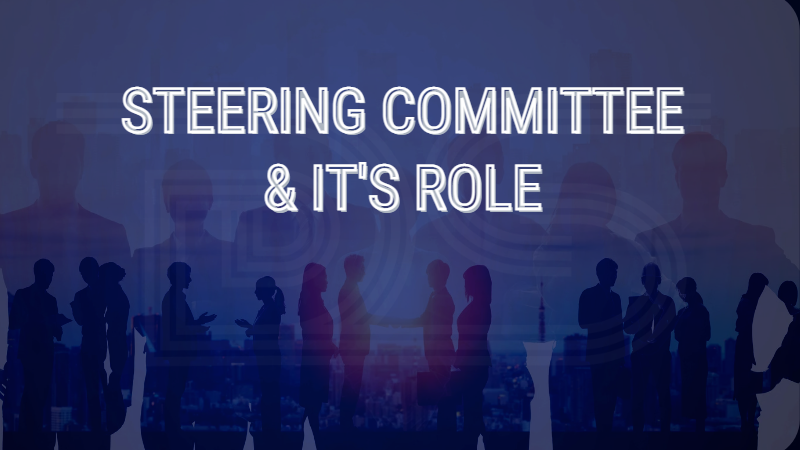
by Dharam CW2 | Jun 4, 2023 | General
Project management may be challenging. Addressing changing business demands, allocating limited resources, and managing team workloads can all result in dealing with complicated project management aspects on a day-to-day basis. However, having high-level assistance and guidance can be a lifesaver. Steering committees accomplish precisely that. Project management steering committees give administrative assistance and troubleshoot issues to keep projects on schedule to achieve their objectives.

Steering Committee
Steering Committee
A steering committee is an advisory body of important stakeholders overseeing and supporting a project to ensure its success. Project steering committees are also known as stakeholder boards, senior leadership teams, and project working groups. They manage projects from beginning to end, offering direction and assistance throughout the project’s lifecycle.
A steering committee’s primary concern is the organization’s direction, scope, budget, timeline, and techniques. Steering committees will meet regularly to discuss these issues to identify where they are and where they want to go to stay on track.

Project Steering Committee
Project Steering Committee
A steering committee may also be a group working together on initiatives. In this case, steering committees assist project managers in ensuring that projects are aligned with business objectives. They identify and manage risks, maintain project quality, and track progress and timeframes. In addition, the committee can approve changes to the project scope, budget, and strategy.
A project steering committee is a part of a larger organization for project governance. Companies that plan major projects that need collaboration across departments and include multiple stakeholders gain from a steering committee that can direct project management. The committee supervises the team’s progress toward fulfilling benchmarks and goals in this role.
The committee is in charge of project management, financial analysis, and recognizing changes that influence the project’s original scope. Furthermore, the project steering committee ensures that all points of view are heard and that any problems between stakeholders or departments are resolved.
Role of a Steering Committee
A steering committee can accomplish its core goal by utilizing a range of group and individual functions. When a steering committee gives advice and guarantees that items are delivered on time and in good condition, a company may reap significant benefits from its project successes. Some of the most important group-based steering committee positions that influence a business’s and consumers’ satisfaction with a product include:
- Providing input on the growth or development of a business or initiative.
- Addressing concerns and offering guidance on budgeting, marketing, recruiting, and other financial issues.
- Identifying the outcomes or objectives that the project must achieve.
- Prioritize the steps and objectives that must be completed to meet the project’s objectives.
- Assisting in the formulation of business-related policies, processes, and guidelines.
- Identifying, monitoring, and eliminating potential operational risks.
- Setting project deadlines or timelines and keeping track of progress.
- Monitoring the final work’s quality.
- Making plans for how a client or consumer will react to a product or service.
- Analyzing and discussing changes that have occurred or will occur to guarantee the project’s success.
- In the workplace, encouraging team members to collaborate.
- Where relevant, providing further insights on business or project concerns.
Members of the steering committee generally do not work on the project directly; nevertheless, committee members may perform various tasks individually to help assure the project’s success. Therefore, individual steering committee members should understand and strive to improve the strategies used to achieve project goals, be genuinely interested in the project and its outcome, promote the project whenever possible, and maintain a broad understanding of project management concerns, in addition to attending team meetings.
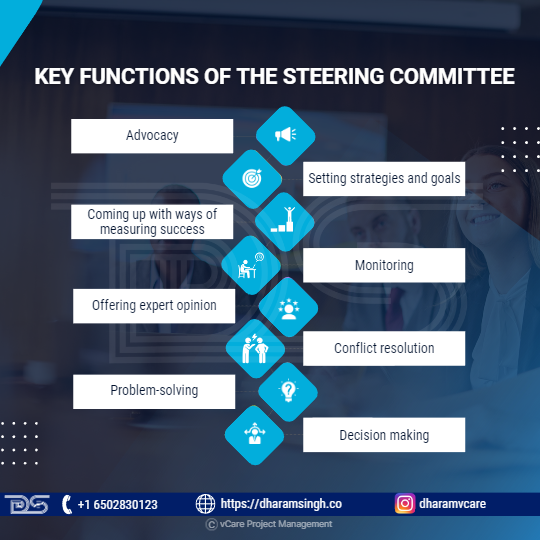
Key Functions of The Steering Committee
A steering committee is an advisory committee made up of various stakeholders and firm officials. They assist in making choices on various initiatives, with members directly interacting with project managers. Here are some of the key functions of the Steering Committee:
- Advocacy
A steering committee advocates for the organization’s varied goals and programs. Remember that it is generally composed of top management and specialists.
- Setting strategies and goals.
Steering committees develop strategic directions for initiatives. They also provide advice and opinions on budgeting, assets, money, time, facilities, marketing, and hiring. Goals and project scope are established as part of their employment.
- Coming up with ways of measuring success
There are several metrics for measuring performance. The steering committee is in charge of establishing how a product’s success is measured.
- Monitoring
The steering committee serves as an advisory body as well as a monitoring body. It ensures that projects fulfill the necessary quality standards and monitors any changes. It also keeps track of project processes and plans, which is critical to project success. The committee also analyzes and monitors project or company hazards before devising solutions to mitigate them.
- Offering expert opinion
The steering committee comprises experts who provide expert opinions on various issues concerning projects or the entire business. Their involvement is generally required, especially while working on a complex project.
- Conflict resolution
Disagreements are normal, mainly while working on a specific project. However, to ensure that issues do not disrupt the overall project, these committees resolve disputes between stakeholders, giving them more time to focus on what is best.
- Problem-solving
One of the functions of any advisory body is to discover solutions to problems the organization may be experiencing. It can generate various problem-solving ideas due to the experts on the strategy committee.
- Decision making
Although the steering committee’s primary function is to provide counsel, it also participates in decision-making. For example, it can analyze, accept, or reject project plans or recommend revisions to the supplied plans based on the members’ feedback.
The committee also engages in role allocation because its members can appoint project managers and other professionals to complete assigned tasks.
Ways to prepare for the project steering committee meeting
Important information and documents must be communicated with all steering committee members before the planned meeting, including:
- Meeting agenda
- Minutes of the previous steering committee meeting
- Project progress report from the project manager
Certain team members should be in charge of creating steering committee meeting documents and scheduling meetings. The steering committee is led by a chairperson who runs the meeting according to the agenda. They also ensure that all committee members express their viewpoints and ideas.
A basic meeting agenda would include the following:
- Recognizing and distributing the previous steering committee meeting minutes with other committee members.
- Conduct a thorough review of action items decided at previous sessions.
- Analyze the project status report filed by the project manager.
- Have a thorough discussion about any additional issues of concern or project requests.
- Select a date, time, and location for the next steering committee meeting.

Steering committee Best Practices For Project Success
Steering committee best practices for project success
Consider the following steering committee best practices for project success, whether you hold your meeting online or in person:
- Allow adequate time for the project team and committee members to prepare.
- Focus on the most important project KPIs and milestones and deliver them to the committee members in a format that everyone can agree on, such as a presentation, report, or infographic.
- Present project facts that are factual, contextual, and relevant. Share any inconsistencies or difficulties as soon as possible before they become significant issues.
- Schedule meetings in advance and automate meeting alerts to go out a week and a day ahead.
- Ensure comprehensive documentation of all meeting discussions and distribute it to committee members before the next meeting.
- Maintain the project charter and refer to it whenever there is doubt about authority, accountability, or strategic direction.

Challenges for Steering Committees
Challenges for Steering Committees
Because project management steering committees are comprised of employees from various backgrounds and functions, they will almost always experience certain challenges. These are some examples:
- Conflicting interests:As the committee includes cross-functional representatives, they will frequently have opposing ideas and interests. People think differently, which may be shown in their behavior, activities, and perspectives.
- Slow decision-making:Team decision-making is typically slower than individual decision-making.
- Lack of clarity in roles:Many committee members may need to know their individual or team responsibilities. A clearly defined charter for the steering committee ensures transparency and clarity about their duties in the project.
Final Thoughts
Every organization needs a Project Steering Committee to lead its transformation initiatives, beginning with a contemporary approach to project management. It may be instantly productive by initiating the process of managing project priorities. Steering committees are extremely crucial in efficient project management. They add value by keeping projects on pace, reducing risks, and resolving problems. When creating one, it is essential to evaluate the overall composition.
The steering committee plays a crucial role in project management that should be considered. The steering committee is the project’s administrator. This functionality does not exonerate the project of responsibility. On the contrary, this role necessitates that the steering committee participates in the project and not simply monitors the project group’s performance from the sidelines. This move will strain the steering committee’s multiple tasks and the time spent on the project.
Feel free to check out my discussion on this topic with Justin Buckwalter in YouTube
For any questions related to your Project Management career, training, and certifications, you can book an obligation free 15 minutes session with me by visiting talktodharam.com
You can subscribe to the vCare Project Management YouTube Channel to catch future videos of our Q&A series and certification success stories: https://bit.ly/2YF0wJl
You can subscribe to and follow my podcasts and interviews with Project Management Experts on YouTube at https://bit.ly/2NDY8wd
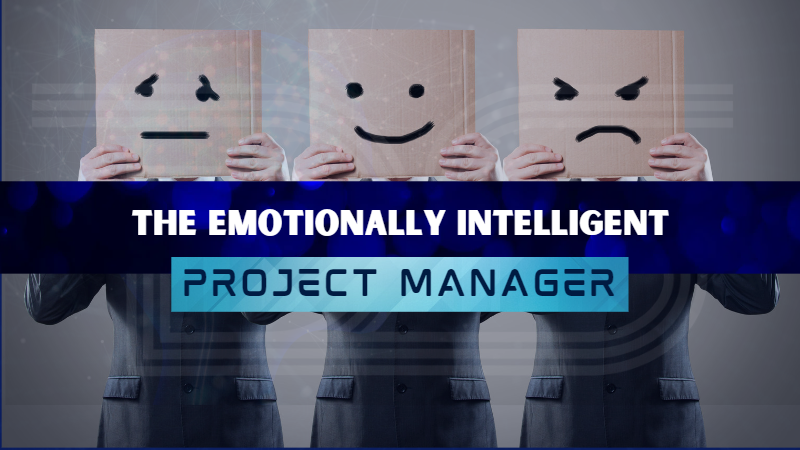
by Dharam CW2 | May 19, 2023 | General
Emotional intelligence in the workplace is becoming increasingly important for leaders and project managers as remote work became more prevalent due to the pandemic. Success in project management and managing cross-functional remote teams is only possible with emotional intelligence.
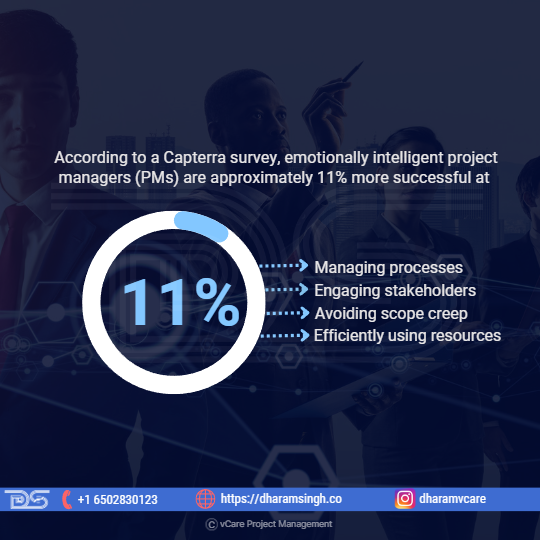
Capterra Survey
According to a Capterra survey, emotionally intelligent project managers (PMs) are approximately 11% more successful at managing processes, engaging stakeholders, avoiding scope creep, and efficiently using resources than PMs who lack this skill.
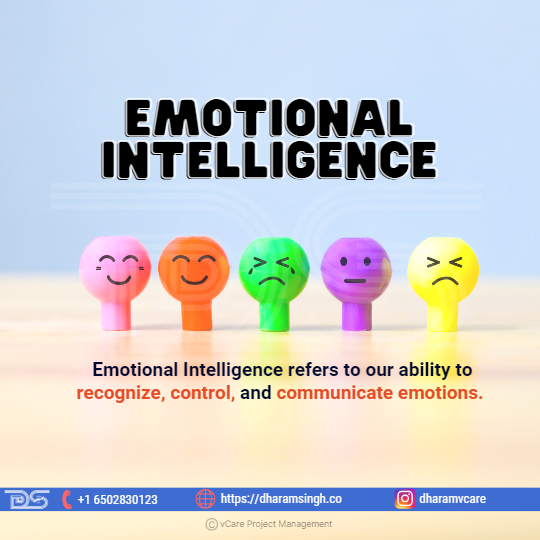
Emotional Intelligence
What is Emotional Intelligence?
Emotional intelligence refers to our ability to recognize, control, and communicate emotions. People with high emotional intelligence understand how they feel, what their feelings imply, and how their feelings affect others. In interpersonal situations, it is also the ability to empathize with others. Emotional intelligence is about creating a positive work environment, which is critical to the success of any project.
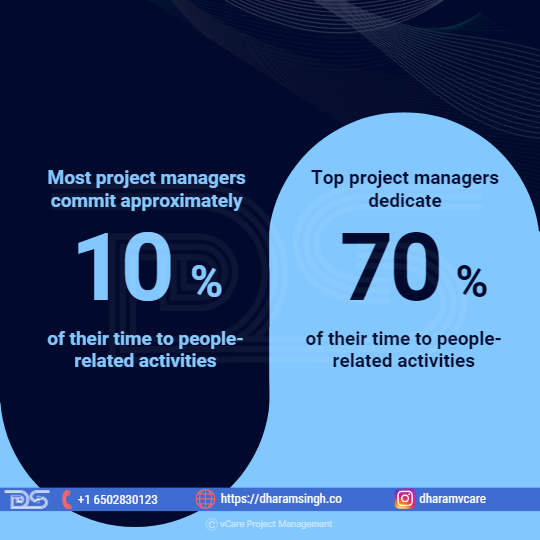
As Per LiquidPlanner Study
According to a LiquidPlanner study, most project managers commit approximately 10% of their time to people-related activities. Top project managers dedicate 70% of their time to these activities. As a result, we can conclude that emotional intelligence is crucial for project success.
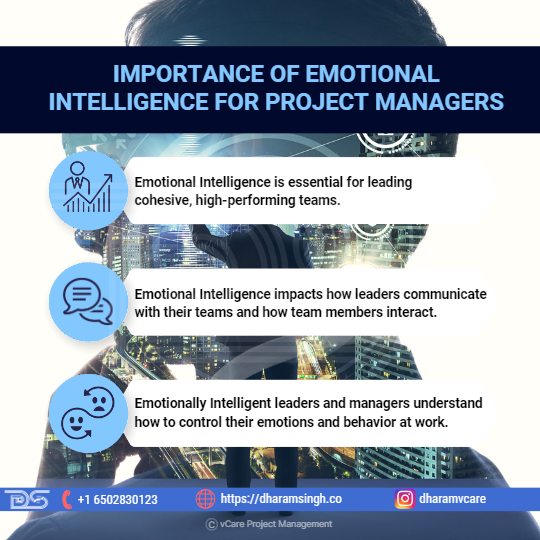
Importance of Emotional Intelligence for Project Managers
Importance of Emotional Intelligence for Project Managers
- Emotional intelligence is essential for leading cohesive, high-performing teams.
- According to researchers and behavioral scientists, Emotional intelligence impacts how leaders communicate with their teams and how team members interact.
- Emotionally intelligent leaders and managers understand how to control their emotions and behavior at work, which includes providing safe environments for exchanging ideas and feedback, productive teamwork and performance, good morale, employee engagement, and job satisfaction. They manage workplace stress and conflict with care and educate their team members to do the same.
Characteristics of Emotional Intelligence
What can project managers do to help themselves develop and become more aware? First, let’s examine five abilities for raising emotional intelligence:
- Self-Awareness – The ability to sense, identify, and comprehend emotions is self-awareness. Unfortunately, many of us were taught to ignore our emotions in the past. However, it is critical to be aware of your feelings to make appropriate decisions and act accordingly. Those with high self-awareness are self-assured, authentic, open to feedback, and capable of maintaining perspective throughout all project phases.
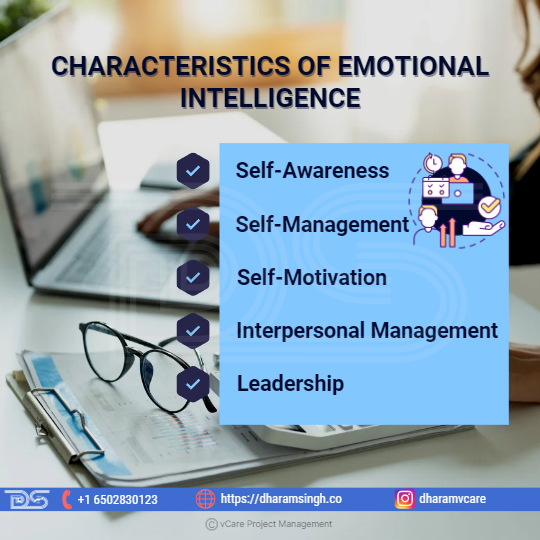
Characteristics of Emotional Intelligence
- Self-Management – Self-management is the ability to reason well while understanding feelings. Many frequently react based on their frame of reference rather than selecting a response based on their current unique circumstances. Self-managers are deliberate in decision-making, taking the initiative, framing events appropriately, maintaining perspective, and responding quickly. They understand their feelings and why they have them and effectively manage their responses.
- Self-Motivation – Self-motivation is the ability to channel the power of your emotions toward a specific goal. When project teams have a purpose, these ‘P’s follow peace, passion, power, perspective, and potential leverage. Self-motivators who are influential are optimistic and have a positive attitude. They can delay gratification and assert themselves.
- Interpersonal Management – The capability to identify and respond properly to the emotions of others is referred to as interpersonal management. If you can connect with people and acknowledge their humanity, they will answer openly, leading to common trust.
- Leadership – An emotionally intelligent project manager inspires guides, challenges, and supports the team. Leadership is defined as the ability to create and communicate vision and passion for assisting individuals and organizations in reaching their full potential.
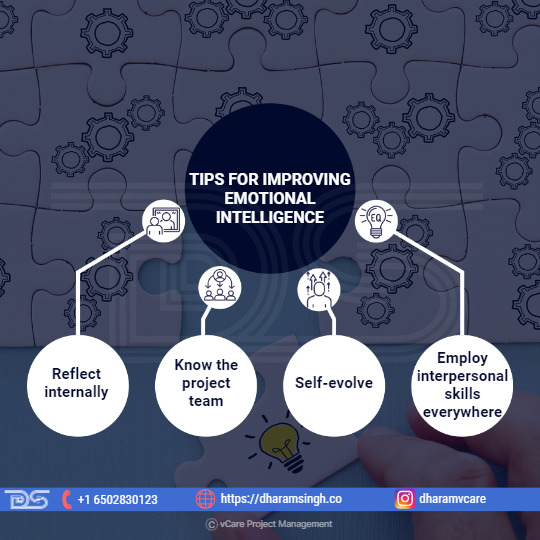
Tips for improving Emotional Intelligence
Tips for improving Emotional Intelligence
- Reflect internally – To become more emotionally aware, one must first understand their emotions and then regulate them in stressful situations. Next, they have to figure out what motivates them. Finally, authenticity is necessary to develop emotional intelligence by leading a successful project team and establishing meaningful relationships with stakeholders.
- Know the project team – Project managers are usually aware of the people they must contact when working on a project. However, understanding the project team, from team dynamics to personalities to dealing with conflict and stress, is just as important. To improve emotional intelligence, one must first get to know their team, communicate with them, and understand their emotions. It will also help the success of their project. This job becomes even more important for teams that operate in multiple locations and are diverse.
- Self-evolve – Along with other important leadership talents, project managers should work to improve their emotional intelligence regularly. Conditions surrounding a project frequently change; its scope may shift, the number of stakeholders may increase, and projects may eventually end.Every project is distinct, and no project manager can complete a project independently. Therefore, it is advantageous for project managers to consider what they learn during and after a project. For example, consider how a project team operated, what they witnessed during critical times with stakeholders, and their team’s performance.
- Employ interpersonal skills everywhere – Emotional intelligence can be helpful in almost any project management situation. For example, people may feel compelled to sign off on a strategy to minimize delays while managing scope changes or project risk. Following the resolution of such issues, an emotionally intelligent project manager would pursue people because they notice that this could lead to more severe problems in the future.
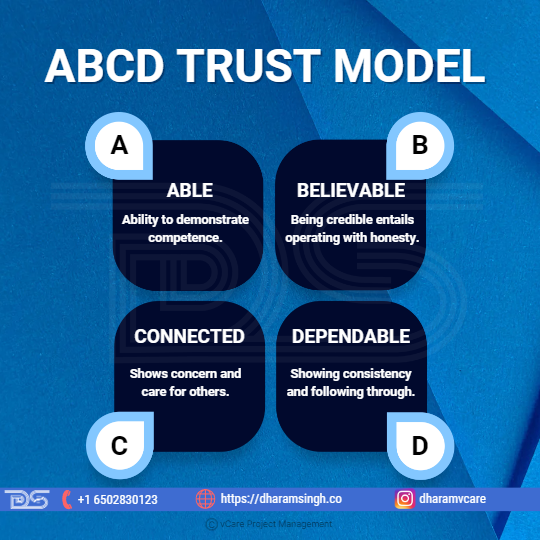
ABCD Trust model
ABCD Trust model
Better relationships will result in better outcomes. That is why developing trusted connections is critical to the success of your organization. When individuals trust one another, they may work efficiently together.
It is well known that low trust harms morale, productivity, and turnover. To prevent these traps, Ken Blanchard created the ABCD Trust Model to help executives understand the activities that affect creating trustworthy relationships.
Blanchard suggests four critical aspects for leaders to develop trust with people: Able, Believable, Connected, and Dependable.
- Able – The term able refers to the ability to demonstrate competence. Leaders demonstrate competence by possessing the necessary skills, education, credentials, and experience. They also exhibit their capacity to lead by accomplishing achievements. Able leaders can encourage people and collaborate with them to achieve goals.
- Believable – Being credible entails operating with honesty. Believable leaders adhere to a set of core beliefs. They know what they stand for and will not compromise their principles under pressure. Being credible also means maintaining promises and not lying or stretching the truth.
- Connected – Connected shows concern and care for others. This aspect fosters trust and contributes to a more engaged workplace atmosphere. Being linked entails attending to people’s needs and promoting their well-being. Leaders also build relationships by giving information not only about the organization but also about themselves. Employees are significantly more likely to provide their best effort when they feel linked to leaders.
- Dependable – Dependable means showing consistency and following through. It entails holding oneself and others accountable for commitments. A trustworthy leader will accept responsibility for their acts and help their followers face adversity.

7MTF Components
7MTF Components
The 7MTF model is composed of seven components. We all have all 7 in our personalities; as adults, 2 to 4 will be strong, some will be weak, and others will be ordinary. This mix of elements is one of the most significant variables in deciding our temperament – our emotional predisposition.
- The R – Regulator (formerly known as the Normal) – A person with a ‘strong R’ has a strong need for Order. They will be mature, responsible, calm, and emotionless. You may hear the words ‘should,’ ‘ought,’ and ‘logical’ in their language. They have high expectations of themselves and others, including those with whom they live and work.
- The G – GoGetter (formerly known as the Hustler) – A person with a ‘strong G’ has a strong desire for material success. This individual entails enjoying money and the things it can purchase. The G is quick, opportunistic, intelligent, enterprising, and charming. They are short-term in nature, expecting results immediately or very soon. Promising a G a large monetary reward next year is unlikely to pique their attention.
- The S – Socialiser (formerly known as the Mover) – The ‘strong S’ personality has a great need to communicate. This aspect implies talking about people, fun, events, what you did over the weekend, or anything related to life. Hence, their straightforward, friendly, and frequent grin immediately.
- The D – Doublechecker – The ‘strong D’ is characterized by a desire to look after others and ensure everyone is safe. When you encounter a strong D, expect someone obedient, loyal, and concerned with doing the right thing. One of their greatest assets is their ability to anticipate difficulties and hazards.
- The A – Artist – A person with a ‘strong A’ desires to create. “I want to be different,” is what they would say. These hardworking individuals are conscientious and do not wish to offend anyone. Seek for anything unusual about their attire, such as innovative earrings, cufflinks, a six-button jacket, or an all-black ensemble!
- The P – Politician – A solid handshake and direct eye contact indicate that the ‘strong P’ is determined to win. This person has a determination and strength that others may find challenging. The spoken word is the strong P’s stock in trade – look for status markers like the huge Mercedes in metallic blue.
- The E – Engineer – A person with a ‘strong E’ personality is driven to accomplish undertakings. The strong E has traits such as process, detail, and procedure. This individual can form a strategy and make it happen as soon as they see anything. The E is concerned with completion. So, unless you can assist, you should avoid getting in the way!
Wisdom – strive for mental stability and individual resilience – 10 Competencies
Wikipedia defines wisdom as the “ability to contemplate and act using knowledge, experience, understanding, common sense, and insight.” Psychologists have created a list of ten competencies that are typical therapies in their field and are referred to as wisdom. Self-awareness, self-control, and empathy are the three components of emotional intelligence (EI). Although the fourth component of EI is not formally mentioned among the ten competencies, social influence or influencing others may be considered a result of being highly effective in the other areas.

Ten Components of Emotional Intelligence
- Ability to change perspectives – In a bipolar environment, it is possible to remain trapped in one thought and dislike the other viewpoint with strong emotions, which may lead to violence. The ability to look for and identify more points of view implies a shift in viewpoint. Some of the therapies used to treat mental illnesses can help with this. Examples include role-playing, acting, visiting people in various countries, learning about diverse cultures, and brainstorming.
- Empathy is the ability to connect – Understanding people’s intentions, current state of mind, emotions, and mindsets is necessary for being heard, establishing trust, and influencing others. In addition, active listening techniques may help you focus outside yourself and view others as humans who vary from ourselves.
- Awareness & acceptance of own emotions (self-awareness) – Self-awareness leads to increased self-confidence and sincerity. It refers to mindfulness, or being aware of one’s feelings, and is required for self-control and emotional balance.
- Emotional balance, serenity (self-control) – Patience, serenity, and avoiding knee-jerk reactions make you more popular and respected and contribute to mental tranquility. Having a mentor can help you develop and fine-tune this skill.
- Knowledge about facts (know what, assimilation) and about problem-solving (know-how, accommodation) – Wisdom includes knowledge; therefore, it has two components.
- On the one hand, we have factual knowledge about a topic; on the other, we may be specialists in a (typically technical) area. This heuristic knowledge and assimilation are how we apply established systems to circumstances.
- On the other hand, when we encounter new situations or topics, we use accommodation to apply our problem-solving skills. We employ our epistemic intelligence and heuristics to do this.
- Contextualism (consider the situation, timeline, and social relevance) – Even though we have theories and may find similarities in new scenarios, each situation is unique and depends on the circumstances, the context in which the problem develops, and the societal importance. This capacity is achieved via awareness and avoiding picking a solution that works in another context without first examining the present dependencies of the situation.
- Relativism for values, tolerance for pluralism, diversity (which is hard if you are part of the same belief systems for most of your life, like nations and churches) – There are many truths (this is known as non-monism), and yours is only one of them. Others have the right to their realities, which are based on the cultures in which they live, their beliefs and experiences, and the facts to which they have access. Value relativism allows one to accept and appreciate the values of others.
- Orientation towards sustainability, willpower, and delay instant gratification (perspective of linear and circular time flow) – We can pursue long-term goals and make decisions with both short and long-term consequences in mind.
- Uncertainty tolerance, ability to strategize (imaging solutions for scenarios) – Accept that life is unpredictable and swim through it like a river, adapting to currents and waves as they come.
- Self-distance, humility – Do not believe you are the center of the universe, which will remain when you die. Avoid being a taker rather than a giver by avoiding jealousy, bragging, pride, and greed.
Final Thoughts
For today’s project managers, emotional intelligence is a critical concept. Many companies are looking for project managers with strong technical and soft skills. Emotional intelligence is crucial in project management because it enables project managers to improve communication and collaboration in the workplace. It is essential to mention that emotional intelligence can be imparted and nurtured. This aspect implies that as a project manager, one can better oneself by controlling feelings and emotions and developing positive behaviors to influence others at work. One will make better decisions about other people’s emotions, strengths, and weaknesses once they have recognized their thoughts.
Feel free to check out my discussion on this topic with Thomas Walenta in YouTube
For any questions related to your Project Management career, training, and certifications, you can book an obligation free 15 minutes session with me by visiting http://talktodharam.com/
You can subscribe to the vCare Project Management YouTube Channel to catch future videos of our Q&A series and certification success stories: https://bit.ly/2YF0wJl
You can subscribe to and follow my podcasts and interviews with Project Management Experts on YouTube at https://bit.ly/2NDY8wd
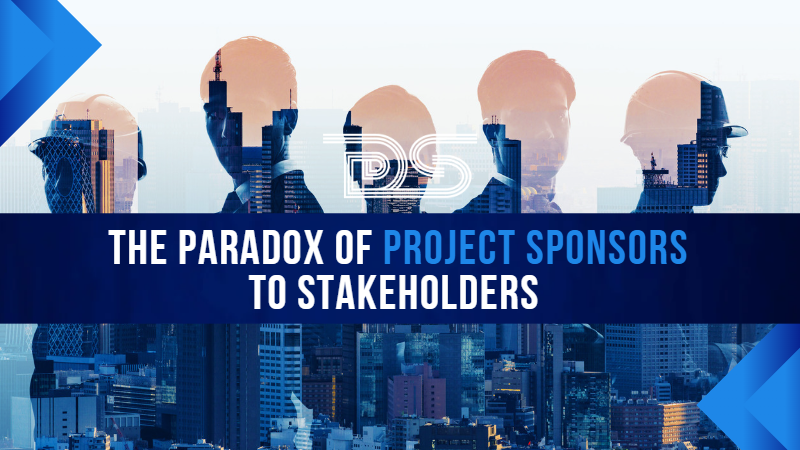
by DharamCW | Mar 10, 2023 | General
A project is deemed successful when it meets or exceeds the expectations of its stakeholders. Every project has a unique set of stakeholders—sometimes far too many. Trying to meet all of their requirements is more often an impossible task. Nonetheless, the project manager must deal with all stakeholder situations smoothly because the stakeholders and the people they represent often evaluate the project’s success.
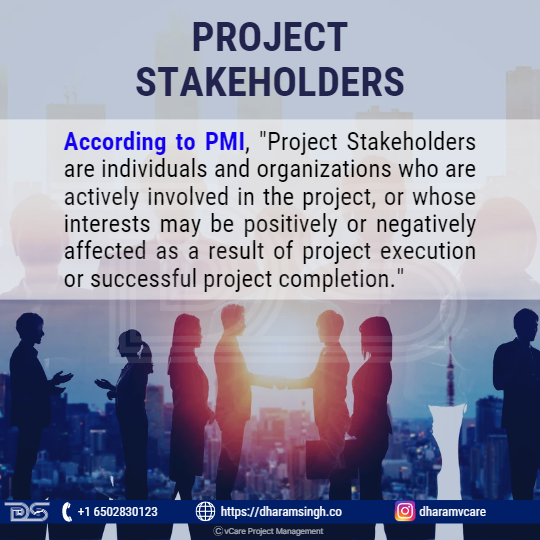
Project Stakeholders
But who are the stakeholders? According to PMI, “Project stakeholders are individuals and organizations who are actively involved in the project, or whose interests may be positively or negatively affected as a result of project execution or successful project completion.”
Stakeholders can be internal or external to the organization that is carrying out the project.
“Project Sponsor” is also a stakeholder, typically an organization executive with authority to assign resources and enforce project decisions. Project sponsors are called internal stakeholders in the project. Stakeholders include the project manager, project team members, and managers from other departments within the organization. Identifying all project stakeholders as early as possible in a project is critical. Leaving out key stakeholders or the department’s function and not discovering the fault until the project is well underway could be disastrous.
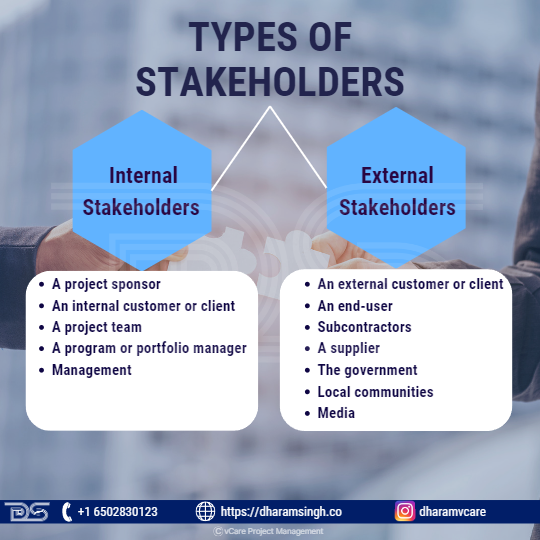
Types of Stakeholders
Types of Stakeholders
There are two types of project stakeholders:
- Internal Stakeholders
- External Stakeholders
Internal stakeholders are individuals or businesses whose relationship with a company is determined by their position within its structure. As the name implies, these individuals are involved in a project from the inside. They are as follows:
- A project sponsor
- An internal customer or client
- A project team
- A program or portfolio manager
- Management
- Another team’s manager of the company
External stakeholders are those interested in a company’s operations. Still, they do not necessarily have a role in the decisions of the business. However, they can influence success or failure based on their vested interests. They can be just as powerful as internal stakeholders. These stakeholders are not directly involved in the project but are affected by its outcome.
- An external customer or client
- An end-user
- Subcontractors
- A supplier
- The government
- Local communities
- Media
Characteristics of Stakeholders in a Project
- When contributing to a project, stakeholders have varying levels of responsibility and authority. This level may change as the project progresses. It can range from one-time contributions to complete project sponsorship.
- Some stakeholders may also actively or passively undermine the project’s success. These stakeholders require the project manager’s attention throughout the project’s life cycle.
- Stakeholder identification is a continuous process throughout the project’s life cycle. Identifying them, understanding their level of impact on a project, and meeting their demands, needs, and expectations are critical to the project’s success.
- Just as they can positively or negatively impact a project’s objectives, stakeholders can perceive a project to have positive or negative outcomes.
- A project manager’s most important role is managing stakeholder expectations, which can be challenging because stakeholders often have different or conflicting goals.
Stakeholder Management
Stakeholder management is the process of organizing, monitoring, and improving relationships with stakeholders. It entails systematically identifying stakeholders, analyzing their needs and expectations, and planning and carrying out various tasks to engage them. In addition, a good stakeholder management process will allow them to coordinate their interactions and evaluate the status and quality of their relationships with various stakeholders.
A critical component of running a successful project is developing and maintaining positive relationships with the affected communities and other stakeholders.
Investing time in identifying and prioritizing stakeholders, as well as assessing their interests, provides a solid foundation on which to build the stakeholder engagement strategy. In addition, good stakeholder management includes ‘business intelligence.
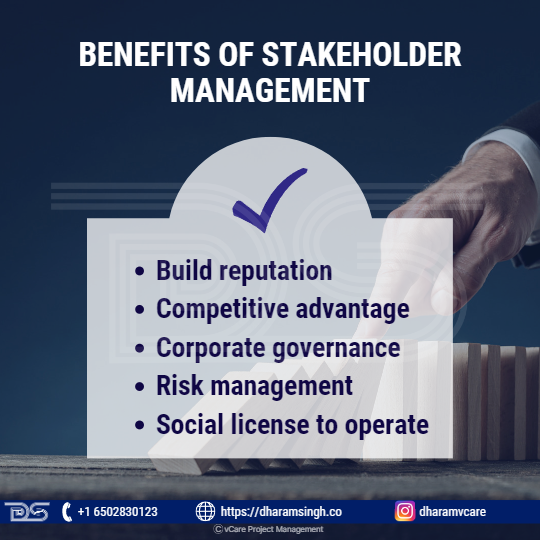
Benefits of Stakeholder Management
Benefits of Stakeholder Management
- Build Reputation
- Competitive advantage
- Corporate governance
- Risk management
- Social license to operate
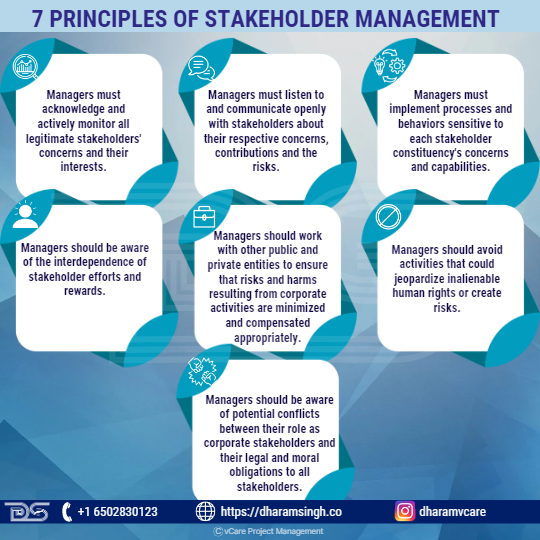
7 Principles of Stakeholder Management
7 Principles of Stakeholder Management
Clarkson Centre created the seven principles of Stakeholder Management for Business Ethics under the leadership of Max Clarkson. The Clarkson Principles are, in many ways, “meta-principles” that encourage management to embrace specific stakeholder principles and implement them according to the norms.
- Managers must acknowledge and actively monitor all legitimate stakeholders’ concerns and consider their interests in decision-making and operations.
- Managers must listen to and communicate openly with stakeholders about their respective concerns and contributions and the risks they face from their involvement with the corporation.
- Managers must implement processes and behaviors sensitive to each stakeholder constituency’s concerns and capabilities.
- Managers should be aware of the interdependence of stakeholder efforts and rewards and make an effort to fairly distribute the costs and benefits of corporate activity among them while taking into account their risks and vulnerabilities.
- Managers should work with other public and private entities to ensure that risks and harms resulting from corporate activities are minimized and compensated appropriately where they cannot be avoided.
- Managers should avoid activities that could jeopardize inalienable human rights or create risks that, if clearly understood, would be patently unacceptable to relevant stakeholders.
- Managers should be aware of potential conflicts between their role as corporate stakeholders and their legal and moral obligations to all stakeholders and address such conflicts through open communication, appropriate reporting and incentive systems, and, if necessary, third-party review.
Understanding the Stakeholders
A good understanding of the stakeholders is the key to successful stakeholder engagement. In addition, understanding stakeholder concerns and interests can lead to product or service ideas that address stakeholder needs while allowing the company to cut costs and maximize value.
1. What else can you learn about stakeholders to better understand their needs, priorities, preferences, and concerns? Consider:
- Demographic data- Ensure to engage with a diverse community and stakeholder groups.
- Social networks- Focus on the important, often undocumented, social connections between stakeholders.
2. Stakeholder Mapping – Stakeholder mapping is the visual process of depicting all stakeholders of a product, project, or idea on a single map. The main advantage of a stakeholder map is that it provides a visual representation of all the people who can have an impact on your project and how they are connected.
3. Salience model – investigate the power, urgency (need for immediate action), and legitimacy (appropriate stakeholders), as well as the interaction or groups of stakeholders that result.
4. Determine stakeholder expectations and compare them to the scope and expectations of the project or organization for which the engagement program is being run. Is there a mismatch in expectations, and how will this be addressed? Consider the following:
- What information do they need from you, how often, and in what format/channel do they want it?
- What is their financial/social/emotional stake in the outcome of the work? Is it favorable or unfavorable?
- What primary motivations will shape their perceptions of your project or organization and their interactions with you?
- What are their current feelings about the organization and project? Is it founded on reliable data?
- Who influences their thoughts, and who are they influenced by?
Ways to deal with common stakeholder problems and challenges
- Stakeholder conflict occurs when different stakeholders have incompatible goals. It causes a “problem” for the company because it can impact its performance and success.
- Conflict necessitates that businesses effectively manage stakeholder interests. Not all stakeholders are strategically important to the company. As a result, businesses must determine which ones should be prioritized.
- Potential problems can be avoided by conducting an upfront analysis of who the stakeholders are and how and when to involve them in the project.
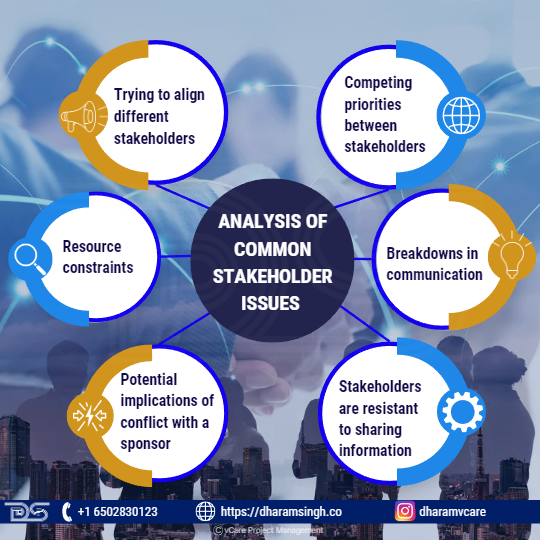
Analysis of common stakeholder issues
Analysis of common stakeholder issues
As no two stakeholders are the same, the issues they may introduce into a project will be vastly different. This factor means there could be many reasons why a project encounters stakeholder resistance or the project team struggles to gain traction. Identifying stakeholder issues during the project can help with planning ahead of time and preparing an appropriate response.
- Trying to align different stakeholders.
It is generally a good thing to have a variety of interests in the project and its outcome, but having a lot of different stakeholders can also pull the project team in too many different directions. In addition, it can be challenging for project managers to coordinate too many different stakeholders, which could add new difficulties to the project.
- Competing priorities between stakeholders
Stakeholders bring their objectives and expectations to the project. However, at least a few of these priorities frequently conflict with or compete with one another. In addition, priorities may vary depending on the department, the role, or the professional backgrounds of the individuals.
- Resource constraints
It’s possible that the team lacks some of the resources they require or that the project is utilizing resources that other stakeholders consider crucial to their projects. Resource competition is common in organizations and can lead to conflict.
- Breakdowns in communication
Effective communication between stakeholders and the project team is crucial for everyone to achieve their objectives and for the project to be successful. When there are communication breakdowns, the project may be delayed, or the team may not receive the necessary information. Without deliberate communication, stakeholders might unintentionally hinder the project’s success.
- Stakeholders are resistant to sharing information.
At times, important project sponsors are more focused on their success and fail to promptly or completely provide the stakeholders with the required information. As a result, stakeholders may attempt to disrupt a project unintentionally or on purpose.
- Potential implications of conflict with a sponsor
Conflict with project sponsors may have many consequences on the project management, such as these typical ones:
- The project’s progress is being slowed
- Reducing the effectiveness and timeliness of decision-making
- Putting team cohesion in jeopardy
- Undermining a project manager’s authority
- Fostering hostility and encouraging uncooperative behavior
- Creating a fearful environment for other stakeholders
- Obscuring the project’s vision
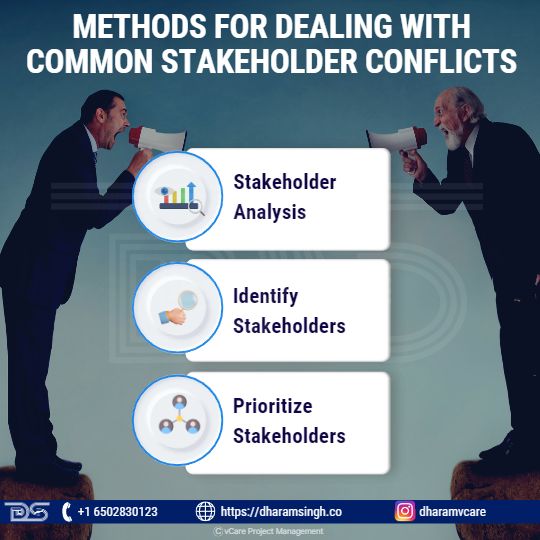
Methods for dealing with common stakeholder conflicts
Methods for dealing with common stakeholder conflicts
- Stakeholder analysis
Stakeholder analysis can offer insightful information and guidance, just as project managers must carefully examine resources and specifics. It can be helpful to respond appropriately by taking the time to consider how stakeholders affect the project’s progress.
By conducting a stakeholder analysis, one can learn how to control expectations, channel stakeholder influence toward project objectives, and deliver the information and updates that stakeholders expect from their team.
- Identify stakeholders
One must first identify the stakeholders to analyze them effectively. List every stakeholder that comes to mind, then include more individuals and organizations as necessary. As stakeholders, all parties involved in the project, those with authority over it or an interest in its success, should be listed.
- Prioritize stakeholders
The list of stakeholders can then be ranked according to impact, interest, and power. For instance:
- Key stakeholders: This first group heavily influences and controls the project. This group is frequently accurate for executive leadership at the company.
- Primary stakeholders: The project immediately affects the key stakeholders. This pack may include team members, departments, and internal or external clients who stand to gain from the project’s outcomes.
- Secondary stakeholders: The secondary stakeholders are those who play a supporting role, are indirectly impacted or have a less significant stake in the project.
Understand the key stakeholders
A few stakeholders are usually critical to the project. Key stakeholders invoke more power and may have a more significant stake in the project’s success than primary or secondary stakeholders. For example, key stakeholders could include their boss, company executives, or team leaders.
Finding the key stakeholders and understanding what they need can help keep the project on track because they may control important resources, have a significant impact on the project, or grant the necessary approval.
Create a communication plan
With a communication plan, project leaders will be better prepared to manage their stakeholders on the fly and keep the project moving forward.
- Create your communication strategy based on what the project leader knows about their stakeholders.
- Keeping track of what the stakeholders require from themselves allows project leaders to stay organized and focused on managing the project.
- Gaining the stakeholders’ trust is essential once the developed strategy has been implemented. Rather than dictating the project to them, make each stakeholder a priority – as appropriate – and give them space to contribute.
Final Thoughts
Different stakeholders in the project have different expectations. Project managers should look for potentially hazardous situations when those expectations might clash. Then, they must address and resolve the conflict or risk endangering the project and themselves.
Resolving stakeholder expectations conflicts is always linked to project success. Furthermore, using various forms of communication among the project team, such as senior management and stakeholders, increases the likelihood of mutual understanding. These techniques help project managers align stakeholder expectations and reduce the possibility of project distress.
Feel free to check out my discussion on this topic with Thomas Walenta in YouTube
For any questions related to your Project Management career, training, and certifications, you can book an obligation free 15 minutes session with me by visiting http://talktodharam.com/
You can subscribe to the vCare Project Management YouTube Channel to catch future videos of our Q&A series and certification success stories: https://bit.ly/2YF0wJl
You can subscribe to and follow my podcasts and interviews with Project Management Experts on YouTube at https://bit.ly/2NDY8wd
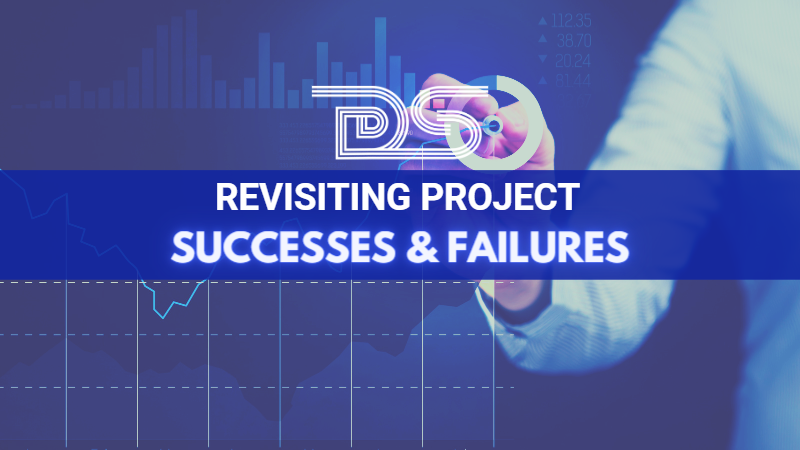
by DharamCW | Jan 15, 2023 | General
A project can be a complex, nonroutine, one-time effort constrained by time, budget, schedule, satisfaction, quality, and scope to meet the customer’s needs. Today, many businesses prioritize project management because it focuses on meeting project objectives and achieving them successfully. Moreover, it got significant because it employs managerial processes and tools that give managers a good chance of achieving their project’s goal.
Project Management Today
Project management has become an essential part of various industrial segments because it crosses corporate and geographic boundaries, adapting to the unique characteristics of various businesses and teams. Here are some of the project trends on the project’s success/ failures.
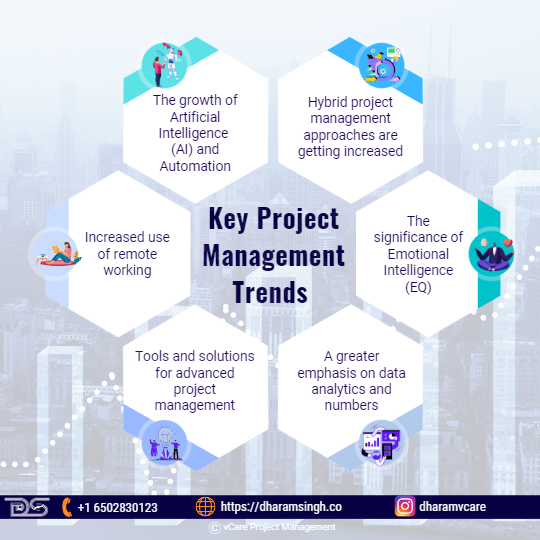
Key Project Management Trends
The Most Important Project Management Trends for 2022
- The growth of Artificial Intelligence (AI) and Automation
- Hybrid project management approaches are getting increased.
- The significance of emotional intelligence (EQ)
- A greater emphasis on data analytics and numbers
- Tools and solutions for advanced project management
- Increased use of remote working
Key Project Management Statistics 2022 (Success and Failures)
Project Success Statistics
- Project management software is used by 77% of high-performing projects. (Hive, 2020)
- 35% of organizations are somewhat satisfied with their project management maturity level. (Wellingtone, 2020)
- 29% of projects are completed on time (Wellingtone, 2020).
- Surprisingly, 54% of organizations lack access to real-time KPIs (Wellingtone, 2020).
- Around 51% of organizations complete projects that meet the business objective or original goal. Meanwhile, 52% of organizations complete projects that meet the needs of stakeholders (KPMG, 2020).
Project Failure Statistics
- COVID-19 had a moderate or significant impact on 58% of organizations, causing project delays and cancellations (KPMG, 2020).
- Organizations with low-value delivery maturity have a project failure rate of 21%, which is significantly higher than the failure rate of organizations with high-value delivery maturity, which is 11% (PMI, 2020).
- 25% of organizations do not use technology suitable for team collaborations on informal projects, despite consuming 20% of their productive time at work (Wellingtone, 2020).
- The most challenging obstacles to implementing agile techniques in an organization are resistance to change (48%), a lack of leadership participation (46%), and inconsistent practices across teams (45%). (Digital.ai, 2020).
- 47% of agile projects are late, have budget overruns, or have dissatisfied customers (Scrum, 2021).
- Understanding these statistics allows project professionals to prepare better for what comes next and make more informed decisions.
Success and Failure of Projects
The business environment is constantly changing, and meeting the customer’s ever-changing needs has become challenging. In addition, customers’ expectations increase as competition in the global market increases. This is sometimes reflected in the pressure that Project Managers face when attempting to provide the best possible value to their customers.
While project management is constantly improving, there are some challenges for which solutions have yet to be found. Global projects are typically getting complex, and as a result, a similar project may be successful in one part of the world while failing in another. Let’s look at the factors for successes and failures on similar projects, as well as how leadership style can help to improve project performance as a contributing factor to the project’s outcome.
Causes of project failure
A project is considered a failure if it fails to deliver on time within the estimated budget. Most project managers have felt the agony of a failed project. In fact, according to a Pulse of the Profession® survey 2021, 12% of projects in an organization failed in the previous year.
When a project is considered a failure?
- First, the project did not meet the expectations.
- The client did not receive the desired deliverable.
- The work was not finished on time.
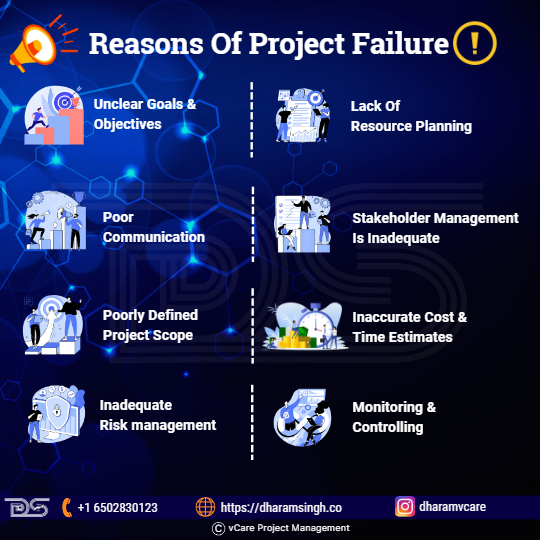
Reasons of Project Failure
So here’s to planning ahead of time and avoiding these common project pitfalls.
- Unclear Goals And Objectives
Businesses that fail to set clear employee goals and objectives waste significant time and effort. The following are the consequences of ambiguous project goals and objectives.
- Unclear objectives lead to ambiguous operational methods.
- Individually, the level of performance can be justified.
- It’s not always obvious when a project deviates from its original path.
- People involved in a project cannot work to their full potential.
- Lack Of Resource Planning
In project management, resources refer to people, money, and materials. Human resources are likely underutilized or overworked if you do not use a good task management tool.
Another critical aspect of project resource planning is financial planning. Projects with poor cost estimation and inconsistent tracking will almost certainly go over budget. In addition, project managers who do not understand how to track and manage finances are more likely to fail the project.
- Poor Communication
Poor communication in the workplace can have disastrous consequences for the project, including poor collaboration and decreased productivity, resulting in stressed employees, dissatisfied customers, and workplace mistrust.
Whether it’s delayed communication, a lack of communication, or no communication at all, the fact is that the project is likely to fall through the cracks if the project professionals don’t have an effective communication strategy in place.
- Stakeholder Management Is Inadequate
Stakeholders have an inherent interest in the project, for better or worse. Project managers are responsible for identifying and communicating with all stakeholders promptly and without delays. Unfortunately, there are numerous reasons for poor stakeholder management, some of which are listed below.
- Stakeholders are too narrowly defined.
- Failure to strike a balance between compliance and strategic opportunities
- Stakeholders are prematurely removing resources.
- Stakeholders’ disinterest
- Stakeholders are unaware of the project’s progress.
Engaged stakeholders provide support and insights to help a project succeed, whereas disengaged stakeholders can become barriers to success.
- Poorly Defined Project Scope
The project scope details everything you intend to do (and not going to do). In project management, scope creep refers to uncontrolled, continuous changes in the scope of a project. Conversely, a poorly defined project scope leads to scope creep, where the former is vaguely defined, documented, or controlled.
A project with an unclear project scope is more likely to fail and encounter a variety of issues, including:
- Failure to meet customer expectations
- Continual changes are being requested throughout the project’s life cycle.
- The budget exceeds the allocated budget.
- Failure to meet deadlines
- Inaccurate Cost And Time Estimates
Inaccurate cost and time estimate frequently result in team members making accurate predictions about the expected duration of tasks and the project’s cost based on an average duration of time and cost for previous projects.
Inaccurate estimates are frequently the result of two underlying causes:
- Upfront planning
- Poor estimation practices
- Inadequate Risk management
Risk management enables project managers to identify and analyze issues that may arise during the project and impede its progress. If risks are not effectively managed, they will likely emerge during the project’s later stages, causing significant scope creep. Conversely, poor risk management can lead to project delays, low user adoption, late assignments, overspent budgets, and project failure.
- Monitoring And Controlling
Monitoring and controlling the project is one of the lesser-known facts that project managers and their teams often overlook. However, a project manager needs to “track, review, and regulate the project’s progress; identify areas that require changes in the planning, and initiate the corresponding changes.”
Every effort should be made to keep the project on track, and if it falls behind budget or schedule, the plan should be adjusted to get the project back on track.
How to Recover a Failing Project?
Three key questions you can ask to quickly and clearly understand the project.
- Are the problems internal or external?
You can determine whether the source of the problem is internal (and thus correctable) or external (outside of your control).
Review project documents such as the charter, plan, and schedule for:
- Requirements from relevant stakeholders.
- A reasonable timetable with attainable goals.
- Allocation of resources
- A method of collecting and managing change requests.
- Unexpected expenses (internal and external).
- Success metrics.
- A procedure for upholding quality standards.
- Why are we behind schedule?
Next, determine why the project is running late.
- Were tasks properly prioritized?
- Were tasks clearly explained?
- Was the timetable overly ambitious?
- How frequently did the project manager provide status updates?
- Who made important project decisions?
- Is there a record of decisions and change requests?
- How were risks communicated and addressed?
- Was the initial budget adequate?
- Is the team working effectively?
Finally, consider how well the team worked together.
- Did the team understand the project’s goal and its roles and responsibilities?
- Was the team using the same procedures and tools?
- Did the team meet regularly to share updates and challenges?
- Was a clear communication strategy in place?
- Were the right people assigned to the project?
- Were there any issues with suppliers or vendors?
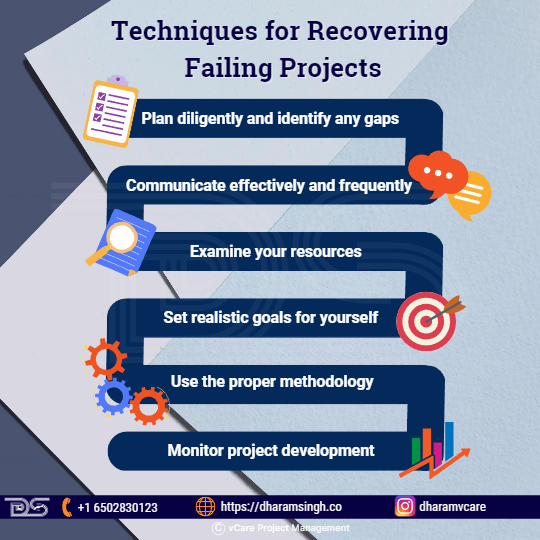
Techniques for Recovering Failing Projects
Techniques for recovering failing projects
While failures are unavoidable in project management, project professionals can always learn from the failures to succeed in the future. So, let’s look at how project managers can ensure that their next project runs smoothly and that any potential problems are identified and resolved before they become too large to cause project failure.
- Plan diligently and identify any gaps.
- Communicate effectively and frequently.
- Examine your Resources
- Set realistic goals for yourself.
- Use the Proper Methodology
- Monitor Project Development
Strategic alignment in project management
Strategic alignment in project management refers to aligning project goals with your organization’s long-term vision and mission.
Contrary to popular belief, strategic alignment in project management does not only refer to establishing and maintaining key financial metrics. Instead, it’s a broad concept that encompasses everything from key financial and quality indicators to customer satisfaction, brand recognition, and value proposition.
Every project has a goal. While some may seek to provide a service or product, others may seek intangible benefits such as positive customer relationships or company goodwill. These strategic goals guide a project professional’s day-to-day business operations and help them turn their ideas into desired results.
Importance of Strategic Alignment in Project Management
- Focus the energy in the right place
- Allow for productive team collaboration
- Describe the organization’s competitive advantages
- Manage priorities that conflict
- Avoid duplication.
- Accept market manoeuvrability
Leadership performance is significant to project success
Effective leadership in project management is the ability to persuade people of the need for change, stimulate new ways of thinking and problem solving, and encourage them to achieve project objectives. Leadership also guides team members to grow as professionals while completing their project responsibilities.
Today’s evidence-based theories of leadership can be characterized into six major classes, which include:
- Attributes
- Behavior
- Contingency
- Visionary
- Emotional intelligence
- Competency
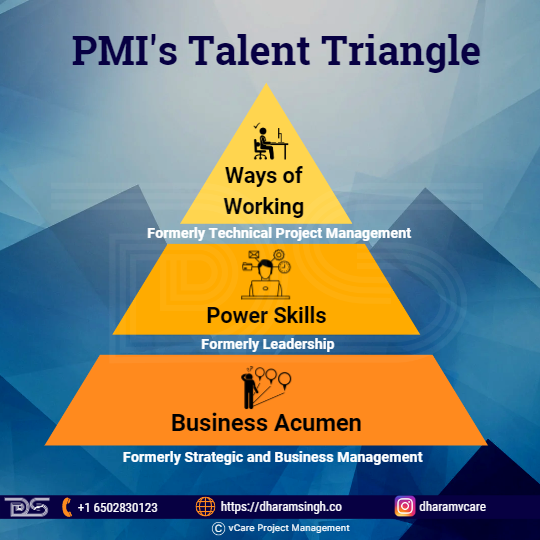
PMI’s Talent Triangle
PMI’s Talent Triangle – How to Stand Out as a Successful Project Manager
Project managers must be more agile and resourceful than ever to keep up with and make an impact in a fast-changing world. PMI has always been dedicated to assisting project professionals in developing strong skills. Nonetheless, project managers now require a skill set that includes a variety of disciplines and practices, as well as other in-demand skills.
To assist project professionals in navigating this changing world of work and embracing smarter ways of working, project professionals need to focus on:
- Ways of Working: Formerly Technical Project Management
- Power Skills: Formerly Leadership
- Business Acumen: Formerly Strategic and Business Management
Factors of project success
Project success has been defined as a project that meets its objectives on time and within budget. A development project’s success extends beyond meeting schedule and budget objectives. It also includes meeting the expectations of beneficiaries, stakeholders, donors, and funding agencies. However, defining these dimensions of success is more complicated and can only be assessed years after the project is completed.
Measuring project success after the fact is important because it aids in determining future strategies when planning new projects. Continuous improvement based on data from past projects enables project managers to identify problems before they occur. Using past data allows new processes to be implemented with fewer errors and greater management success.
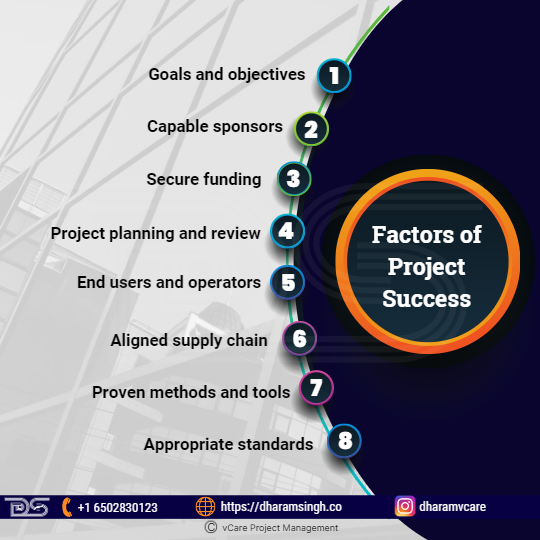
Factors of Project Success
Here are some of the factors for the project’s success:
- Goals and objectives
The project’s overall goal is specified and recognized by all stakeholders; it is not at odds with subsidiary objectives, and project leaders have a clear vision of the project’s outcomes.
- Capable sponsors
Sponsors play an active role in the project’s life cycle; they bear ultimate responsibility and accountability for the project’s outcomes.
- Secure funding
The project has a secure funding base; contingency funding is recognized from the start, and budgets are strictly regulated to ensure maximum value is realized.
- Project planning and review
Pre-project planning is thorough and considered; progress is monitored regularly and carefully; the project has realistic time schedules, active risk management, and a post-project review.
- End users and operators
End users or operators are involved in the project’s design; the project team works with users who can effectively and efficiently implement what the project has produced.
- Aligned supply chain
All direct and indirect suppliers know the project’s requirements, timelines, and quality standards. As a result, the supply chain’s higher and lower tiers are coordinated.
- Proven methods and tools
Good project management tools, methods, and techniques are used to maintain an effective balance of flexibility and robustness.
- Appropriate standards
Quality standards are actively used to drive output quality. In addition, other standards are regularly monitored to ensure delivery at the best practice levels.
Knowing what success factors are important at the end of a project is critical for assessing how that project went and making changes for the next one. It is critical to understand what distinguishes success from failure.
By investing time in learning about the future of project management, project professionals will be better prepared to capitalize on new opportunities and develop their skill set accordingly. So many opportunities for growth and success are on the horizon; use these trends and factors to propel your company, projects, and team to new heights!
Feel free to check out my discussion on this topic with Thomas Walenta in YouTube
For any questions related to your Project Management career, training, and certifications, you can book an obligation free 15 minutes session with me by visiting talktodharam.com
You can subscribe to the vCare Project Management YouTube Channel to catch future videos of our Q&A series and certification success stories: https://bit.ly/2YF0wJl
You can subscribe to and follow my podcasts and interviews with Project Management Experts on YouTube at https://bit.ly/2NDY8wd

by DharamCW | Jun 12, 2022 | General
Two relevant quotes which quickly strike our minds when we think about the Entrepreneurial mindset are:
“Building a business is not rocket science; it’s about having a great idea and seeing it through with integrity.” Richard Branson
“At 211 degrees, water is hot. At 212 degrees, it boils. And with boiling water comes steam. And with steam, you can power a train.” S.L. Parker
Ideally, a project’s success is based on the critical success factors identified during the initial stages of the project, which would fall in various areas such as Process, Product, Project Management, Business, and Strategic. When the project can make a positive and long-standing impact on business value, a culture deeply imbibes into people’s minds. It creates an undeniable mark in the overall scheme of things.
Benefits and stakeholders’ satisfaction are the key factors that measure a project’s success. It’s also defined by the level of efficiency the project creates based on the set project objectives. Project success is based on the project success criteria and outcome. Typically, these criteria fall as Meeting the Scope identified, Deadlines and Milestones on time, Within the given budget, excellent satisfaction to the stakeholders, both internal and external, and with specified quality criteria.
Essentially, we all know that various tenets of project management contribute to success. Here, we will discuss how the entrepreneurial mindset would impact project success. Entrepreneurs have some unique characteristics such as being adaptive, decisive, risk-tolerant, persistent, able to handle failure, experimenting, building teams, etc.,
Mindset
One must believe that we can be malleable to unlock our growth as project managers or portfolio managers by transforming into an entrepreneurial mindset. We need to understand what mindset is, then understand the characteristics of an entrepreneurial mindset and how we can embark on that transformation journey from where we are to bring on project success in our project management career.
Mindset is an essential set of beliefs that provides a shape in terms of the view one has on the world and themselves. It influences how we think, act, feel and respond to a given situation. Typically, mindset falls into two categories as introduced by Carol S. Dweck, which we are all aware of: they are a) Fixed Mindset and b) Growth Mindset.
An entrepreneurial mindset is a growth mindset. Intelligence cannot be developed with a fixed mindset. A growth mindset is all about the belief that intelligence can be developed through personal effort, good learning strategies, and lots of mentoring and support from others. As introduced by Heider, the interpersonal process equation is a product of Ability, Motivation, and Environment.
An entrepreneurial mindset is a set of skills that allows people to recognize and capitalize on opportunities, overcome and learn from setbacks, and succeed amidst challenging backdrops. An entrepreneurial mentality is a method of thinking that helps achieve your business objectives. Entrepreneurs who learn from their mistakes and failures have a better chance of future success.
Entrepreneurs boost the economy by creating jobs and developing new products and services that benefit the entire world. A great entrepreneur must be able to think outside the box and come up with out-of-this-world ideas.
Entrepreneurial mindset and project management

7 Entrepreneurial Traits
Though there is a common belief that entrepreneurship cannot be taught, and they should be born, studies have proven that it’s a myth. Typically, entrepreneurs search, seize and exploit the opportunities while mitigating them through engagement, courage, and perseverance. The following are the entrepreneurial traits that are generally encompassed in an entrepreneur:
- Commitment and Determination
- Courage
- Obsession with opportunity
- Risk tolerance
- Creativity
- Motivation to excel
- Leadership
An entrepreneurial mindset fosters more value for projects. Your project teams are encouraged to solve business problems and develop creative and innovative ideas. When a leader allows the teams to be creative and innovative, they will be more productive and engaged in the project.
The journal “People’s confidence in innovation” indicates that confidence in innovation is a component of the entrepreneurial mindset. In several ways, confidence in innovation can be considered part of the entrepreneurial mindset.
- First, entrepreneurs have more confidence in innovation than non-entrepreneurs.
- Second, confidence in innovation is positively related to other aspects of the entrepreneurial mindset, most notably self-efficacy, opportunity alertness, risk propensity, and role-modelling.
- Third, according to (Nochian and Schtt’s 2012) study, entrepreneurs are not like other people. Instead, their network appears to be the source of their confidence. In the same way, highly networked owners or managers are highly confident in innovation.
- Fourth, their innovativeness appears to be a result of their confidence. The more confident entrepreneurs are, the more innovative they are.
Entrepreneurial mindset and Project success
Commitment & Determination
Commitment and Determination would encompass Decisiveness, Tenacity, Discipline, persistence in solving problems, willingness to sacrifice, and being completely immersed in the mission. In the context of project management, each of these characteristics would contribute to the project’s success. For example, it is being decisive in terms of critical path challenges and exhibiting tenacity for unblocking issues without giving excuses for the need of the project and solving problems. Being committed requires a lot of sacrifice and discipline to bring on consistency. When being disciplined, it would require more like a parenting skill which would always course correct in the larger interest of the project, though seen to be tough externally. Discipline is brought about by establishing an unalterable set of rules and regulations to follow for the project’s success.
Courage
The definition of courage is “mental or moral strength to venture, persevere, and withstand danger, fear, or difficulty” (Mish, 1994, 266). Courage could be implemented with excellent values through moral strength, fearless experimentation, unafraid of conflicts, no fear of failure, and intense curiosity amidst facing risk. A courageous project manager would tackle the controversies and conflicts in the project early. A fearless project manager could put his job on the line in the pursuit of doing The Right Thing for the project. Often, the project manager would not have the necessary support and face active resistance, which needs to be managed with resolve to move beyond personal discomfort through intense curiosity.
Obsession about opportunity
An entrepreneur constantly looks for opportunities for improvement. Similarly, project managers consistently look for opportunities for improvement daily by observing day-to-day activities seeking to do more, do better, and do differently. Obsession with opportunity would be recurring, which would preoccupy or intrude on the project manager’s mind. This obsession would naturally shape the opportunity and help focus on project needs. Obsession with opportunities drives business value through the project.
Risk Tolerance
Good project managers would tolerate risk while being calculated risk-taker and risk sharers, thereby minimizing the risks. He would exhibit the characteristic of an entrepreneur by showing the ability to manage stress/conflict and ambiguity. Especially when the project has larger integrations and frequent changes would increase the ambiguity and uncertainty proportionally. Generally, the unknowns which are in the project would cause ambiguity. The ability to understand those would help identify the risks involved. PMBOK defines these areas in terms of Risk tolerance, Risk appetite, and risk threshold. It guides the management of these effectively through appropriate processes involving planning, controlling, and appropriate level of communication.
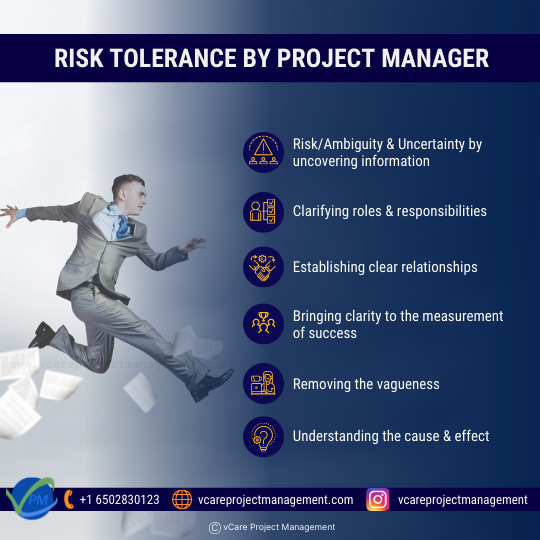
Risk Tolerance
Project managers should learn how to maneuver ambiguity. As ambiguity would be sinusoidal over time, it would arise and settle. The project manager must manage risk/ambiguity and uncertainty by uncovering information, clarifying roles and responsibilities, establishing clear relationships, bringing clarity to the measurement of success, removing the vagueness, and understanding the cause and effect.
Creativity
So what is creativity? In “The Social Psychology of Creativity,” Amabile (1983) defines creativity as,
“A product or response will be judged as creative to the extent that (a) it is both a novel and appropriate, useful, correct or valuable response to the task at hand, and (b) the task is heuristic rather than algorithmic” (p. 33).
Creativity can be multiple things. It would always push your limits by being open-minded, lateral thinking, ability to conceptualize by going into details, and ability to adapt. Creativity can be unleashed in project setup during Brainstorming sessions, Root Cause Analysis, Force field analysis, Affinity Diagrams, SWOT Analysis, etc. Creativity can be fostered further by open communication and providing an environment for the resources involved. As a project manager, one needs to remove the mental blocks like “Always looking for the right answer,” “avoiding ambiguity,” “I’m not creative,” “Always looking for concrete answers,” and “That’s not my area,” etc., Encourage creative aspects through “Why not like that,” “Let’s explore more,” “what value it would bring in,” etc.,
Motivation to excel
There is a popular phrase. Projects don’t succeed; people do. Typically the project’s success is always attributed to the people. People tend to have a goal and result orientation and need a self-imposed drive to achieve the results. Typically entrepreneurs keep motivating themselves and others around them despite all odds. People involved in projects need interpersonal support, understanding of weaknesses, and guidance to overcome them. Essentially aspects like having a sense of humor and perspective on the value they are adding to the project would motivate them to do better. The project manager’s responsibility is to understand individuals and adopt appropriate motivations strategy based on their needs, desires, and goals. They reward the team and its members creatively by recognizing their strengths. Make the project goals and success factors visible to the entire team. They are clarifying how the performance will be validated as an exact measure.
Leadership
Leadership is one of the essential traits entrepreneurs have. They would be self-starters and have a strong internal locus of control. Locus of control is the degree to which people believe that they, as opposed to external forces (beyond their influence), have control over the outcome of events in their lives. The concept was developed by Julian B. Rotter in 1954 and has since become an aspect of personality psychology. Project managers with an Internal Locus of Control believe that every event in their life derives from factors under their control. These individuals tend to blame or praise themselves for whatever success or failure they experiment in life. They would have enormous patience, integrity, and reliability. They would build teams and more leaders. Key attributes of communicating with a project management mindset include empathy, clarity, authenticity, and flexibility.
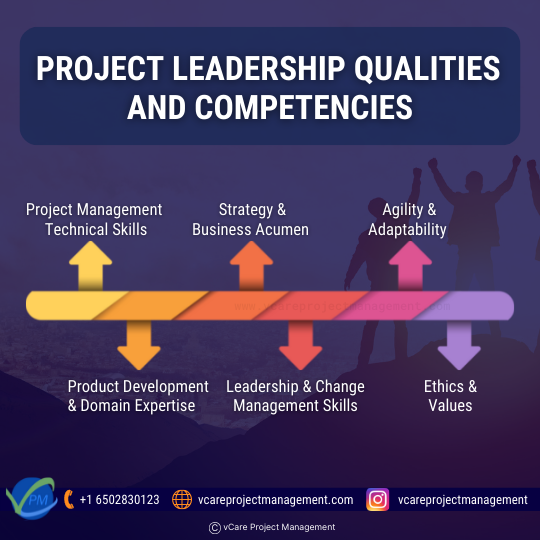
Project leadership qualities and competencies
Successful projects come as an outcome of a well-coordinated team effort. Project managers as leaders know their team very well.
The entrepreneurial mindset’s key aspects of a project’s success
Being confident and open-minded is crucial for a project professional with an entrepreneurial mindset. It’s about being self-assured, optimistic, and never afraid to take risks. Every day, if you have an entrepreneurial mindset, you will be ready to take action to achieve your goals and acquire project success.
While some scholars have examined aspects of the entrepreneurial mindset and provided general insights into its attributes, qualities, and operations, the question remains how people tap into it.
- The cognitive aspect—how do entrepreneurs use mental models to think?
- The behavioral aspect—how do entrepreneurs engage or act for opportunities?
- The emotional aspects—what do entrepreneurs feel in entrepreneurship?
Project leadership qualities and competencies
When the project requires success, both project managers and project sponsors should take up the role of a project leader by demonstrating leadership talents, competencies, and entrepreneurial mindsets. The following are the most significant features of effective project management:
- Project management technical skills
- Product development and domain expertise
- Strategy and business acumen
- Leadership and change management skills
- Agility and adaptability
- Ethics and values
Conclusion
The entrepreneurial mindset is an important factor leading to project success. Many leading authors agree with this point of view and are researching to substantiate this grounded theory. This endeavor to bring out the factors associated with the project manager’s leadership style profoundly impacts project success.
Feel free to check out my discussion on this topic with Thomas Walenta in YouTube
You can subscribe and follow my podcasts and interviews with Project Management Experts on YouTube at https://bit.ly/2NDY8wd
You can subscribe to vCare Project Management YouTube Channel to catch future videos of our certification Q&A series and student success stories using the link https://bit.ly/2YF0wJl
For any questions related to Project Management career, training, and certifications, you can book an obligation free 15 minutes session with me by visiting talktodharam.com







































Recent Comments